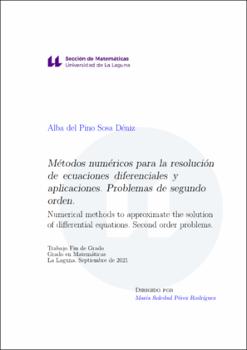Métodos numéricos para la resolución de ecuaciones diferenciales y aplicaciones. Problemas de segundo orden
Author
Sosa Déniz, Alba del PinoDate
2021Abstract
El objetivo de este trabajo es el estudio de los m´etodos Runge-KuttaNystr¨om (RKN) para la resoluci´on de problemas de valor inicial
(PVI) en ecuaciones diferenciales ordinarias (EDO) de segundo orden. En primer lugar, profundizaremos en el estudio de los m´etodos
Runge-Kutta (RK) para PVIs de primer orden, ya que los RKN son
una extensi´on natural de ellos. Esto es importante ya que abordar
directamente la convergencia de los m´etodos RKN es bastante complejo sin conocer antes c´omo se deducen las condiciones de orden de
los m´etodos RK y, en particular, la teor´ıa de las series de Butcher.
A partir de esta teor´ıa, demostraremos dos teoremas relevantes. El
primero da una acotaci´on rigurosa del error local del los RK y se
usa para demostrar el segundo, que nos asegura la convergencia de
dichos m´etodos. Establecida ya esta base s´olida, pasaremos a extender estos m´etodos a los PVIs de segundo orden, definiendo los
m´etodos RKN y estudiando su orden y convergencia. Finalizaremos
esta memoria aplicando estos m´etodos para la integraci´on temporal
de la ecuaci´on de ondas y testando su comportamiento con varios
experimentos num´ericos. The aim of this work is to study Runge-Kutta-Nystr¨om (RKN)
methods for solving initial value problems (IVPs) in second-order
ordinary differential equations (ODEs). First, we will delve into
the study of Runge-Kutta (RK) methods for first-order IVPs, since RKNs are a natural extension of them. This is important since
tackling directly the convergence of RKNs is quite difficult without
first knowing how the order conditions of RK methods are deduced
and, in particular, the theory of Butcher series. Then, we will prove
two relevant theorems. The first one gives a rigorous bound of the
local error of RK methods and is used to prove the second one, which
ensures the convergence of RK methods. Having established this solid
foundation, we will extend these methods to second-order IVPs, defining RKN methods and studying their order and convergence. We
will conclude this report by applying these methods to the time integration of the wave equation and testing their behaviour with several
numerical experiments.





